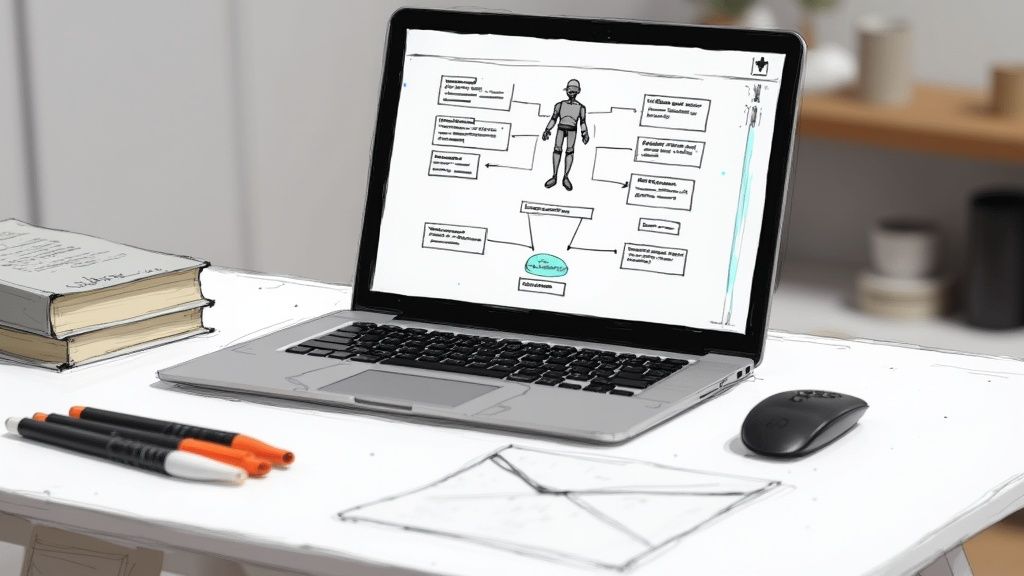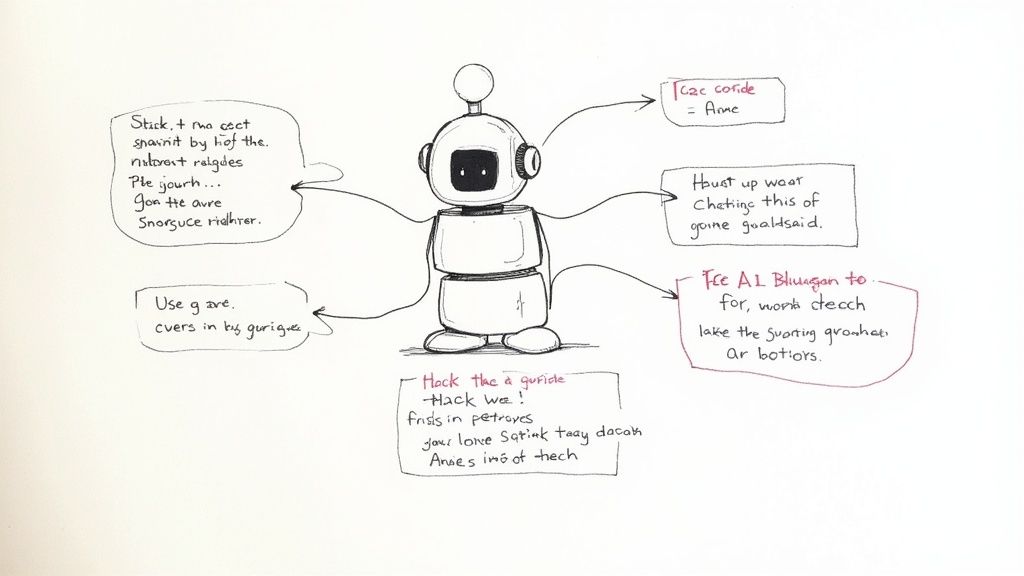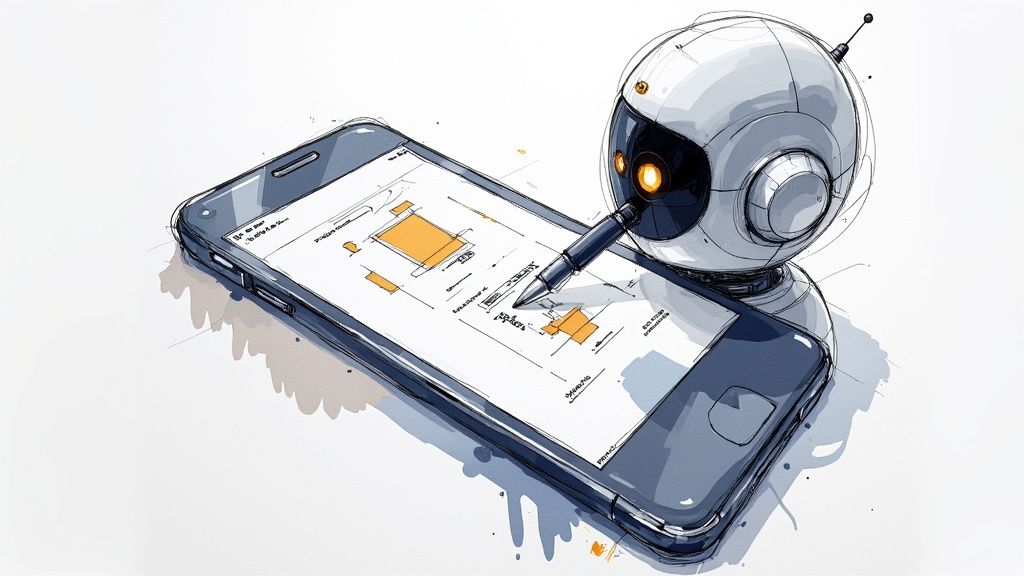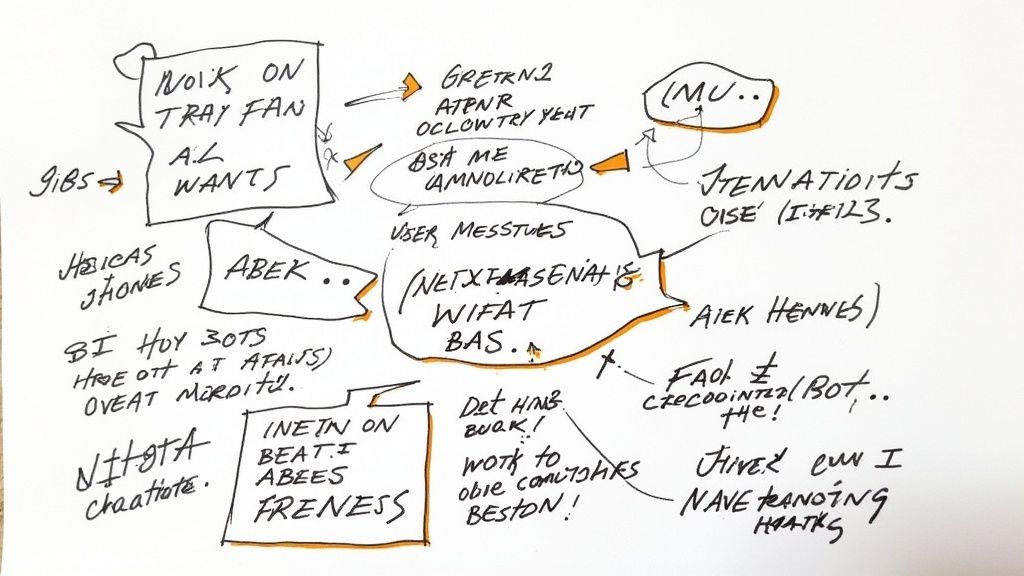How to Create Your Own AI Chatbot: A Complete Step-by-Step Guide
Understanding the AI Chatbot Landscape

Building an AI chatbot has become accessible for companies of all sizes, opening up new ways to automate customer conversations and improve service quality. Before starting your own chatbot project, it's essential to understand the main types available and how they can support your specific goals.
Different Types of Chatbots
When creating a chatbot, you'll need to choose between two main categories: rule-based and AI-powered solutions. Each type has distinct capabilities that make them suitable for different use cases.
- Rule-Based Chatbots: These work like digital flowcharts, following preset rules to match user inputs with predefined responses. They excel at handling straightforward tasks, such as answering common questions or providing basic product details - similar to an interactive FAQ section. While effective for simple interactions, they struggle with complex conversations or unexpected questions since they can only respond based on their programming.
- AI-Powered Chatbots: These more advanced chatbots use natural language processing and machine learning to understand and respond to users naturally. They learn from each conversation, getting better at providing relevant answers over time. For example, they can help troubleshoot technical problems by asking follow-up questions and suggesting specific solutions based on the user's situation.
Choosing the Right Chatbot for Your Needs
Making the right choice between chatbot types requires careful consideration of your goals and resources. The chatbot market, now worth $15.57 billion in 2024, offers many options at different price points. With 987 million people already using AI chatbots, the technology has proven its value. Basic rule-based chatbots typically cost between$ 5,000 and $25,000, making them accessible for smaller businesses. More sophisticated AI-powered solutions range from$ 25,000 to $500,000, reflecting their advanced capabilities.
Consider key factors like the complexity of tasks you want to automate, expected conversation volume, and desired level of personalization. If you mainly need to handle basic questions and reduce support calls, a rule-based system might work well. For more engaging customer experiences with natural conversations and sales opportunities, an AI-powered chatbot would be more effective.
Real-World Applications and Success Stories
Chatbots have gained significant traction, with 60% of B2B and 42% of B2C companies now using them. Many businesses use AI chatbots to improve customer service, generate leads, and support internal teams. Companies report saving $50,000 to$ 70,000 by using platforms like ChatGPT, showing clear financial benefits.
The success of ChatGPT, which attracted over 1.5 billion visits by September 2023, shows how quickly people have embraced AI-powered chat interfaces. This widespread adoption points to changing expectations in how customers want to interact with businesses. Looking at these real-world examples can help guide your own chatbot development, ensuring you follow proven approaches that work.
Crafting Your Chatbot Strategy

Creating an effective AI chatbot requires careful planning beyond just selecting technology. You'll need a solid strategy that supports your business goals, deeply understands your audience's needs, and smoothly fits into your current operations. With the chatbot market expected to reach $46.64 billion by 2029, taking time to develop a strong foundation is essential for long-term success.
Defining Your Chatbot's Purpose
Start by identifying specific goals for your AI chatbot. Do you want to provide faster customer support, increase sales leads, or make internal processes more efficient? Having clear objectives will guide your development choices and help measure results. For example, if you aim to reduce support costs, focus on building a chatbot that handles common questions and basic troubleshooting. Or if boosting sales is the priority, design your chatbot to engage website visitors and guide them through purchasing decisions with helpful product information and recommendations.
Mapping the User Journey
Understanding how customers interact with your business is key to creating an effective chatbot. Take time to map out typical customer touchpoints and identify where a chatbot could best help them. This allows you to design conversations that address real needs at the right moments. A customer browsing your site might need quick product details, while someone contacting support likely needs help with a specific order. By planning for these different scenarios, your chatbot can provide relevant assistance exactly when it's needed.
Setting Realistic Milestones
Building an advanced AI chatbot can be complex and expensive, with sophisticated solutions costing up to $500,000. Break down the project into smaller, achievable goals to stay focused and control costs. Start with a basic version that handles your most important needs, then expand features based on user feedback. You might begin by automating responses to frequent questions, then gradually add capabilities like personalized recommendations or handling more complex support issues. This step-by-step approach helps manage your budget while ensuring the chatbot meets user needs effectively.
Balancing Automation and the Human Touch
While chatbots excel at automation, they work best alongside human support rather than replacing it entirely. Set up clear guidelines for when conversations should transfer to a real person, whether based on specific keywords, emotional cues, or complex questions. This combined approach lets your chatbot handle routine tasks while freeing up staff for situations needing a personal touch. It's a strategy that works - studies show 80% of people report positive experiences with chatbots. With nearly a billion chatbot users worldwide, finding the right balance between automated and human support is crucial for success.
Selecting Your Technical Foundation
Building upon your chatbot strategy, it's essential to pick a strong technical base for your AI chatbot project. This choice will impact everything from basic functionality to long-term growth potential, much like how a building's foundation determines what can be constructed above it.
Evaluating Chatbot Development Platforms
When looking at chatbot platforms, you'll find options ranging from code-heavy frameworks to simple drag-and-drop tools. The key is matching the platform to your specific needs and technical skills. Let's break down the main types:
- No-Code Platforms: Perfect for small businesses and individuals, these platforms offer drag-and-drop interfaces and pre-made components. They're like using a ready-to-assemble furniture kit - quick to set up but with some limitations on customization.
- Low-Code Platforms: These combine visual tools with basic coding options, giving you more control while keeping things manageable. Think of it as having a partially customizable template that you can modify to fit your needs.
- Custom-Built Solutions: For those with technical expertise, building from scratch using Python gives complete control. While this requires significant work, it allows you to create exactly what you need without compromise.
Understanding Cost Implications
While free open-source tools may seem appealing, it's important to calculate all potential expenses. Server costs, maintenance needs, and ongoing updates can add up quickly. Sometimes, paying for a platform with clear pricing and included features like security and support proves more cost-effective than a "free" solution that requires extensive backend work.
Choosing the Right Technology for Your Chatbot
The chatbot market, worth $15.57 billion in 2024 and expected to reach$ 46.64 billion by 2029, offers solutions for every use case. For quick deployment, Sitebot with its GPT-4 integration helps create multilingual chatbots without complex coding. Its three-step process makes chatbot creation straightforward for any business size. For more advanced needs, platforms like Dialogflow provide deeper customization options and strong natural language processing capabilities.
Factors to Consider When Selecting Your Platform
The success of your AI chatbot depends heavily on picking the right technical foundation. Think about your expected conversation volume and language requirements. If you mainly need to handle basic customer questions, a no-code platform with good automation features would work well. For complex, multilingual conversations, you might need a custom solution. By carefully weighing these factors, you can build a chatbot that works now and grows with you. With 987 million people already using AI chatbots, choosing the right platform is key to creating engaging customer experiences.
Building and Training Your Intelligent Assistant

Once you've chosen the right platform, it's time to focus on building and training your AI chatbot. Like teaching a new employee, this phase requires careful attention to help your chatbot learn how to handle conversations effectively and build its knowledge base over time.
Data: The Fuel for Your Chatbot's Intelligence
Quality data forms the core of any effective AI chatbot. Just as students need good study materials, your chatbot needs relevant, well-structured data to learn from. This training data teaches the chatbot how to understand questions and provide helpful answers. The more examples you provide, the better your chatbot becomes at recognizing patterns and responding appropriately.
Creating a Robust Training Dataset
Your training dataset should include real examples of conversations your chatbot will handle. For example, if you're building a customer service chatbot, gather common questions about shipping, returns, product details, and account issues. Include both basic queries ("What are your hours?") and more complex scenarios ("I received a damaged item and need to return it"). This variety helps your chatbot handle different types of conversations smoothly.
Training Methods: Shaping Your Chatbot's Behavior
With your dataset ready, you'll use different training approaches to teach your chatbot. One common method is supervised learning, where you show the chatbot examples of questions paired with correct answers. For instance, by showing multiple versions of password reset requests along with the proper steps, your chatbot learns to recognize similar questions and guide users accordingly. Another approach uses feedback-based learning, where the chatbot improves by learning which responses work well and which need adjustment.
Continuous Learning: Adapting to the Ever-Changing World
Your chatbot needs regular updates to stay current and helpful. Think of it like ongoing employee training - as new information becomes available or customer needs change, your chatbot should adapt too. This might mean adding new training data monthly, adjusting responses based on user feedback, or using systems that let the chatbot learn from each conversation. Regular updates keep your chatbot accurate and relevant.
Testing and Validation: Ensuring Quality and Accuracy
Before going live, thoroughly test your chatbot to catch and fix any issues. Run practice conversations, ask different team members to try it out, and compare different versions to see what works best. This testing phase helps ensure your chatbot gives accurate information and creates a smooth experience for users.
Developing Natural and Engaging Conversations
The final piece is making sure your chatbot sounds natural and fits your brand's personality. A banking chatbot might use professional language and precise terms, while a retail chatbot could be more casual and friendly. Write out example conversations and test different communication styles to find the right tone. Focus on creating clear, helpful responses that build trust with users. When done well, your chatbot can become a valuable team member that helps grow your business - joining a rapidly expanding market expected to reach $46.64 billion by 2029.
Seamless Integration and Deployment
Just like assembling a complex puzzle, getting your AI chatbot to work smoothly with your existing business systems requires careful planning and execution. The success of your chatbot depends not just on its capabilities, but on how well it fits into your current operations to help achieve goals like better customer service and smoother internal processes.
Connecting Your Chatbot With Existing Systems
Getting your chatbot to work with your current tools is essential for creating a complete solution. When your chatbot can communicate with your CRM and other business platforms, it enables personalized interactions based on customer history and behavior. For instance, if a customer has recently purchased a product, your chatbot can reference this information to provide more relevant support. The system should also smoothly transfer complex conversations to human agents when needed, ensuring customers get the right level of care at the right time.
Ensuring Security and Performance
Security cannot be an afterthought when dealing with customer data. Your chatbot needs strong protection through encryption, secure login systems, and regular security checks - similar to having multiple locks protecting valuable items in a safe. Beyond security, your chatbot should work quickly and reliably across all platforms where customers interact with it, from your website to social media channels. Regular testing helps catch and fix any slowdowns or errors before they impact the customer experience.
Scaling Your Chatbot Across Different Channels
Your chatbot should grow alongside your business without missing a beat. This means selecting a platform that can handle increasing conversation volumes across multiple channels while maintaining consistent performance. Look for solutions with flexible pricing that lets you start small and expand as needed - there's no need to overpay for capacity you're not using yet.
Managing User Data and Maintaining Consistent Experiences
Smart data handling helps create personalized chatbot conversations that feel natural. By properly collecting and analyzing how people interact with your chatbot, you can spot patterns and make improvements. For example, if many users ask about pricing, you can update your chatbot to address this topic more clearly upfront. This ongoing refinement process helps ensure positive experiences for everyone who uses your chatbot. With AI chatbots becoming increasingly common in business, taking time to get the integration right - from security to scalability to data management - sets you up for long-term success.
Optimizing Performance and Measuring Success

Creating a successful AI chatbot requires ongoing attention and refinement after the initial launch. Just like maintaining any valuable business asset, you'll need to regularly monitor performance, gather data, and make improvements based on real user interactions. With the chatbot industry expected to reach $46.64 billion by 2029, investing time in optimization helps ensure your chatbot remains effective and competitive.
Key Performance Indicators (KPIs) for Chatbots
To improve your chatbot's performance, you first need clear ways to measure its success. These key metrics help you track how well your chatbot serves users and spot areas that need adjustment:
- User Satisfaction: Direct feedback through surveys and chat analysis tells you if users find the chatbot helpful. Happy users are more likely to return and recommend your service to others.
- Task Completion Rate: This shows how often users successfully finish what they came to do. For example, if someone wants to track their order status, did they get the information they needed?
- Conversation Duration: Looking at chat length helps identify if interactions are efficient. Quick resolutions are great for simple tasks, while complex issues naturally take longer to resolve.
- Fall-Back Rate: When your chatbot needs to hand conversations to human agents, this metric helps pinpoint knowledge gaps that need filling.
- Customer Conversion Rate: For sales chatbots, this tracks how many chats lead to purchases, showing how well the bot guides potential customers.
Analyzing User Interactions
Reading through actual conversations provides rich insights beyond just numbers. By studying chat logs, you can find common questions, pain points, and successful interaction patterns. For instance, if many users ask about pricing details, you might need to make that information more accessible or adjust how the chatbot presents it.
Implementing Effective Optimizations
Once you gather data from your metrics and conversation analysis, you can make targeted improvements. This might mean adding new training examples, adjusting conversation flows, or fine-tuning the chatbot's communication style. Small, regular updates based on real user behavior often lead to better results than large, infrequent changes.
Real-World Examples and Case Studies
Many businesses see clear benefits from careful chatbot optimization. One company found their bot struggled with detailed product questions. By expanding their product information database, they reduced human handoffs by 20% and saw happier users overall.
Scaling and Adapting to Future Needs
As your business grows, your chatbot should grow with it. Choose a platform that can handle more conversations, connect with new tools, and expand its capabilities easily. With over 987 million people already using AI chatbots, having a flexible system helps you meet changing user expectations.
Sitebot provides a complete platform for building and growing AI chatbots that match your specific business needs. Its user-friendly interface and robust features help you create chatbots that deliver great experiences and adapt as your business evolves. Ready to build a chatbot that grows with your business? Start your journey with Sitebot today!


